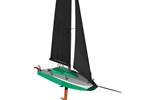Sicomin infuses Couach's superyacht with bio-based epoxy resin
Sicomin’s InfuGreen 810 was used to vacuum infuse Couach’s 26-meter, 52-ton superyacht’s hull, deck and superstructure, for a lighter, faster, more durable yacht.
Sicomin’s (Châteauneuf les Martigues, France) InfuGreen 810 bio-based epoxy infusion resin has been used for the infusion of the new Couach (Bordeaux, France) Fly 86/2600 Motor Yacht — reported to be one of the largest structures to be infused with bio-resins to date, and by far the largest yacht hull.
Sicomin’s InfuGreen 810 was used for the vacuum infusion of the 26-meter, 52-ton superyacht’s hull, deck and superstructure, which is said to produce a lighter, faster, more durable yacht and significantly reduce overall fuel consumption.
With a long history of building in composites, Couach has developed highly efficient vacuum infusion processes to build hull, deck, superstructure and other components for itd vessels. While Couach traditionally used polyester resin systems, Sicomin — a supplier of composite materials to the shipyard for more than 15 years — has worked with the Couach R&D team for the past four years on a test program to explore the benefits of epoxy resin systems, culminating in the successful implementation of Infugreen 810 and other GreenPoxy bio-based epoxies in the latest Couach model.
With 38% of its carbon content from plant-based sources, Sicomin says InfuGreen 810 is formulated to provide a more sustainable vacuum infusion resin. With the testing program complete and DNV GL type approval in hand, Couach prepared to infuse the 2600 Fly hull.
Sicomin also supplied release agents compatible with its epoxies and vacuum consumables. Then, the highly engineered E-glass laminate, including sandwich core sections and a range of stitched multiaxial, woven and unidirectional fabrics were assembled in the hull mold. For the final pre-production stage, Couach installed its in-house-developed monitoring system to monitor the process conditions during the infusion itself.
Infusion of the first Fly 86/2600 hull was completed by Couach technicians with Sicomin’s technical team on site to support the process and observe the infusion of the bio-epoxy hull. InfuGreen 810 was also used for deck and superstructure components with GreenPoxy 33 bio-based hand laminating resins used for secondary bonding in the yacht’s final assembly.
“Our InfuGreen 810 resin offers the optimum solution for infusion in a large structure such as the Fly 86/2600,” comments Philippe Gruaud, head of technical sales for Western France, Sicomin. “The significantly lower viscosity and increased fiber wetting enable rapid, controllable and void-free infusion of the laminate, particularly when using heavyweight, multi-axial and woven reinforcement plies. It’s not just a more sustainable option, it’s the best technical option for a project like this.”
The first of the new Fly 86/2600 series launched earlier this year, with the second hull currently in production.
Related Content
-
Syensqo becomes new Solvay specialty materials company
Syensqo represents what was Solvay Composite Materials, focused on delivering disruptive material technologies and supporting growing customer needs.
-
Daher CARAC TP project advances thermoplastic composites certification approach
New tests, analysis enable databases, models, design guidelines and methodologies, combining materials science with production processes to predict and optimize part performance at temperatures above Tg (≈150-180°C) for wing and engine structures.
-
TPI manufactures all-composite Kenworth SuperTruck 2 cab
Class 8 diesel truck, now with a 20% lighter cab, achieves 136% freight efficiency improvement.


















